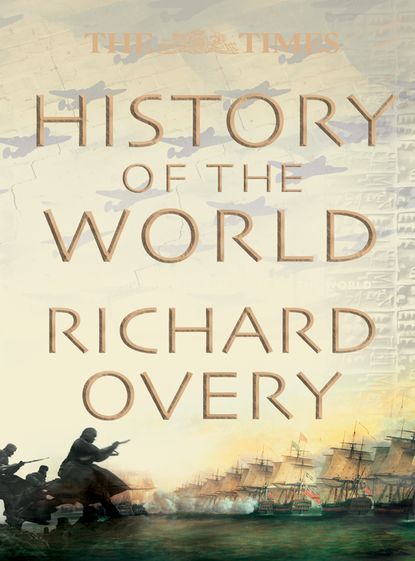По всем вопросам обращайтесь на: info@litportal.ru
(©) 2003-2024.
✖
The Times History of the World
Настройки чтения
Размер шрифта
Высота строк
Поля
Even before Alexander’s conquest, some communities within the Persian empire had adopted aspects of Greek culture. This “Hellenization” continued, at least among the elites: conflict between “Hellenizers” and “traditionalists” in the 2nd century led to violence in Jerusalem. However, especially in Seleucid territories, elements of older cultures, including cuneiform writing, remained important, and in those areas which were to become the Parthian empire (see p. 57), Greek culture was never firmly established.
There were advances in geometry and mathematics, especially with Euclid of Alexandria and Archimedes. The great Alexandrian librarian, Eratosthenes of Cyrene, attempted with some success to calculate the circumference of the earth. However, this was not a period of great technological change. The basis of the Hellenistic economy was agriculture, and this changed little. Merchants continued to trade, and writers of the time praise the range of goods available in the great cities, but there is evidence too of an increasing gulf between rich and poor. Only in warfare were there major developments, with the creation of ever more advanced artillery and siege engines, and the introduction by the Seleucids and the Ptolemies of elephants onto the battlefield.
From the late 3rd century, a new player entered the game. Threats to Roman operations in the Adriatic, and Macedonian support for the Carthaginian Hannibal, led to a Roman invasion of Greece and Asia Minor. The Macedonian phalanx proved inferior to the Roman legions.
THE GROWTH OF ROMAN POWER
Wars gave Roman commanders an opportunity for booty and glory, and initially they withdrew their forces after each campaign; but as Rome acquired more allies in the east, the reasons for maintaining their presence grew. After the battle of Pydna (168) the kingdom of Macedon was divided into four independent republics. 18 years later it was made a Roman province. The involvement of Cleopatra VII in the civil war between Mark Antony and the future emperor Augustus led after the battle of Actium (see p. 75) to the Roman annexation of Egypt, the last major successor kingdom. A few small client kingdoms, tolerated by the Romans for a while, were all that remained of Alexander’s territorial inheritance.
475 BC TO AD 220
THE UNIFICATION OF CHINA
The process of China’s nation- and empire-building began with the political anarchy of the Warring States period but ended with a highly centralized state headed by a single monarch and an efficient bureaucracy that reached village level. The new system attained its full glory under the Han, whose wealth and territory matched the Roman empire.
Throughout the Warring States period (475–221 BC) seven major rivals contended for supremacy. At first, following the decline of the power of the Chou king, the principal contenders were the old-established dukedoms of Ch’i, Ch’u, Han and Wei. But from the beginning of the 3rd century BC the border state of Ch’in established firm control over the northwest and west, adopting the title “king” in 325 BC, and during the latter half of the 3rd century BC it began gradually destroying its rivals.
Throughout China, it was a period of constant warfare, waged on a massive scale by powerful and well-organized political units. But at the same time, this Warring States period coincided with major economic and social changes. The introduction of iron tools from about 500 BC and the use of animal power for cultivation greatly increased agricultural productivity. Population multiplied, commerce and industry flourished and large cities emerged. It was also a period of innovation in technology and science, and of philosophical ferment, in which the main schools of thought—Confucianism, Daoism and Legalism—took shape.
That the Ch’in emerged from this period to unify China under their leadership was at least in part due to the success of the “Legalist” system adopted by them in the 4th century, whereby a universal code of rewards and punishments was established that induced a high level of popular obedience and military discipline. Under this system, a centralized bureaucracy took measures to improve the production and distribution of grain, and organized the population to provide manpower for construction works and for the army, enforcing the system through a ruthless penal code.
THE FIRST EMPEROR
When the Ch’in king, Shih Huang-ti, was crowned the first emperor of China in 221 BC, the “Legalist” institutions were extended throughout the country. But although the emperor tried to eliminate all hostile factions, under the burdens imposed on the people by his military campaigns and vast construction works, his dynasty collapsed in a nationwide rebellion in 206 BC, shortly after his death.
After a period of civil war a new dynasty, the Han, was established by Liu Pang (256–195 BC). Copying the general outlines of the Ch’in system, but softening its harshness and in part restoring a system of feudal principalities, the Han gradually evolved an effective central government and system of local administration. The “Legalist” approach was replaced by Confucianism which emphasized benevolent rule and good statesmanship.
HAN EXPANSION
The Ch’in had taken strong defensive measures against the nomad Hsiungnu (Huns) in the north. Under the emperor Wu-ti (140–87 BC), though probably driven by his generals in the north, Han China again took the offensive against the Hsiungnu, and opened up the route to central Asia known as the Silk Road. A large export trade, mainly in silk, reached as far as the Roman empire. The Han also reaffirmed the Ch’in conquests in the southern region, eliminated the Yüeh kingdoms of the southeast coast, and occupied northern Vietnam. Chinese armies also drove deep into the southwest, seeking to establish Han control. In addition, Wu-ti’s armies placed parts of northern Korea under Chinese administration.
The Han empire grew extremely prosperous and China’s population reached some 57 million. Many large cities grew up and the largest, the capital Ch’ang-an, housed a population of a quarter of a million and was the centre of a brilliant culture. At the beginning of the Christian era the Han empire rivalled that of Rome in size and wealth.
But under a series of weak emperors during the latter half of the 1st century BC, the authority of the throne was challenged by powerful court families. In AD 9 Wang Mang usurped the throne. His reign (the Hsin dynasty, AD 9–23) ended in a widespread rebellion that restored the Han (Later Han, AD 25–220), and the capital was moved to Lo-yang.
THE COLLAPSE OF THE HAN EMPIRE
After some decades of consolidation, in the late 1st century the Chinese resumed active hostilities to drive the Hsiungnu westward to central Asia. But trouble with the Chiang tribes of the northwest and virulent factionalism at court had seriously weakened the Han state by AD 160. A wave of agrarian distress culminated in 184 in a massive uprising led by the “Yellow Turbans”, a religious movement based on popular cults. Although the Han survived in name until 220, power now lay with regional commanders. In 220 the empire was divided into three independent kingdoms, ushering in a long period of territorial fragmentation.
220 TO 618
CHINA AND EAST ASIA
The period after 220 was one of the most chaotic and bloody in Chinese history. Not only was the north lost for long periods to non-Chinese regimes, but the governments in the south often lost effective control as well. Political instability was the norm across the country, and economic growth was minimal until the advent of the Sui dynasty.
The Han empire broke up into three kingdoms in 220: the Wei in the north; the Wu in the south; and the Shu in the west. The militarily strong Wei had conquered the Shu in the southwest by 263, but in 265 a military family, the Ssu-uma, took over the Wei kingdom through a coup d’état. They then proceeded with a series of military campaigns to unify China under the name of the Western Chin dynasty. The target of unification was finally achieved in 280.
THE WESTERN CHIN
The new authorities granted farmers land-holding rights to re-establish household farming in accordance with the Han model. “Salary land” for officials was granted and cultivated by tenants. Overall, this helped the recovery of the agricultural economy. The adoption of a laissez-faire Daoism by the new rulers as the state philosophy was also precedented in the Han. At the same time Buddhism became increasingly widespread.
Politically, however, the ruling class was deeply divided. In the period from 291 to 306, there were numerous assassinations and violent struggles within the royal family, known as the “Wars between Eight Princes”. The unitary empire existed only in name. The weakness of the Western Chin regime created opportunities for the non-Chinese peoples within and on the borders of the empire—the Hsienpei, Hsiungnu, Chieh, Ti and Ch’iang—to move in and establish their own kingdoms, as many as 16 at one time. This was known as the “Five Barbarians’ Disruption of China” and practically ended the Western Chin. The Chinese regime survived under the Eastern Chin only in south China. Its territory was much smaller than the area controlled by the non-Chinese regimes in the north and its authority over the population severely weakened. Tax avoidance became endemic.
During the years of the Eastern Chin, north China saw near permanent conflict among the non-Chinese regimes. The unification of the north finally arrived in 382 under the Ch’ien Ch’in and after their failed invasion of the south in the following year an era of co-existence was ushered in between the non-Chinese regime in the north and the Chinese one in the south. Based on this ethnic division, the period is called the “Northern and Southern Dynasties”.
In the south the Eastern Chin dynasty ended with its overthrow in 420 by one of its generals, who established the Sung dynasty. There followed another three short-lived dynasties, each in turn brought down by either a general or another member of the ruling family, although outside the court there was a measure of peace and prosperity.
THE NORTHERN WEI
In the north a dynasty of Hsienpei descent, the Northern Wei, managed to conquer all of north China in the early 5th century, but split into two lines in 534, to become, in 550 and 557 respectively, the Northern Ch’i and Northern Chou. Although the latter was smaller and poorer, it had a more efficient military organization, and overcame the Northern Ch’i in 577. Within a few years, however, its ruling family was overthrown by one of its partly-Chinese generals, Yang Chien, who went on to conquer the south and establish the Sui dynasty. Although it was itself short-lived, the Sui had at last reunified China.
500 BC TO AD 550
INDIA: THE FIRST EMPIRES
From 500 BC to AD 550 south Asia witnessed a succession of metropolitan empires centred in north India—the Mauryas, the Kushanas and the Guptas. Although centralized political control was often weak, for the first time the entire subcontinent was integrated within a single but diverse cultural field.
By about 500 BC north India sustained 16 well-articulated polities, or “mahajanapadas”, some of which were still essentially tribal republics and others were already monarchies. This region witnessed tremendous change, as the consolidation of settled agriculture led to the emergence of cities and more complex political systems. Such changes made the older sacrificial cult of the Vedas, which had its origins in the pastoral communities of the Aryan tribes, increasingly obsolete. In its place, at the end of the 5th century BC in the heart of the Gangetic plains, the founders of Buddhism and Jainism formulated their radical new teachings.
THE FIRST EMPIRE
During the 5th century BC the number of mahajanapadas diminished to four—Vajji, Kosala, Kasi and Magadha. After a century of wars, the single kingdom of Magadha dominated, with its splendid new capital of Pataliputra. This was to be the nucleus of the first Indian empire. Shortly after Alexander’s incursion into India in 327 BC, the Mauryan prince Chandragupta seized the Magadhan throne. Chandragupta then conquered the land east of the Indus, swung south to occupy much of central India, and in 305 BC decisively defeated Alexander’s successor in the northwest, Seleucus Nicator. The Mauryan empire that Chandragupta founded reached its zenith under his grandson, Ashoka, who established his rule over most of the subcontinent. Ashoka’s empire was composed of a centralized administrative system spread over a number of thriving cities and their hinterlands. After his conquest of Kalinga in 260 BC, Ashoka publicly converted to Buddhism and adopted a policy of “conquest through righteousness”, or dhammavijaya. In a number of public orders inscribed on pillars and rockfaces throughout the subcontinent, Ashoka called for peace, propagated moral teachings (dhamma), and prohibited Vedic animal sacrifices. These edicts, written in Prakrit, are the first specimens of royal decrees in south Asia.
THE KUSHANA EMPIRE
Mauryan rule did not long survive Ashoka’s death in 232 BC. In the 2nd century bc, the northwest was repeatedly invaded, both by Greeks from Bactria and Parthia, and then by new nomad groups themselves displaced from central Asia. First among these were Scythian tribes called the Shakas who overran Bactria and the Indus valley in the 1st century BC. Then the Kushana branch of the Yüeh-chih horde, who had settled in the Oxus valley after 165 BC, gradually extended their rule inland, subduing the Shakas in western India and reaching Varanasi in the 1st century AD. As well as the Oxus and Indus valleys, large parts of Khotan were included in their cosmopolitan empire, centred in Purusapura. Kushana India was a melting pot of cultures. The empire reached its height of power and influence under Kanishka, who patronized Buddhism and became extensively involved in political conflicts in central Asia.
Both the Shakas and the Kushanas took Indian names and were the first kings to adopt Sanskrit at their courts—the first courtly poems in Sanskrit date from this period—though the native kingdom of the Satavahanas of the Deccan continued to use Prakrit. In the northwest Mahayana Buddhism emerged at this time from more conservative teachings known as Theravada, and developed a more eclectic outlook, emphasizing compassion and worship in an enlarged Buddhist pantheon.
In the same period, India’s ancient trading links with the west were revitalized and greatly extended as the Roman empire rose to power. Ports such as Barbaricum, on the Indus delta, and the entrepot of Barygaza exported turquoise, diamonds, indigo and tortoise-shell, receiving in return a flow of pearls, copper, gold and slaves from the Arab and Mediterranean worlds. Much of the Chinese silk traffic found its way to the city of Taxila, before caravans took it further west. Trade led to other exchanges, as Buddhism spread to central Asia and China.
By the middle of the 2nd century AD the south had also witnessed economic development. The Satavahanas of the Deccan developed a powerful empire and established overland and coastal trading networks and the weaker Tamilspeaking kingdoms of the south established ports on both coasts of the peninsula.
THE GUPTAS
In the 4th century, the native dynasty of the Guptas imposed a new rule, based again in Pataliputra. Following the campaigns of Samudragupta and his son Chandragupta II, their suzerainty was acknowledged over an area almost as great as that of the Mauryan empire. Until repeated Hun incursions ended Gupta power in the 6th century, the Gupta period saw the blossoming of earlier cultural trends, and has become known as the “classical” or “epic” age of Indian history.
2300 TO 50 BC
THE PEOPLES OF NORTHERN
EUROPE
The late Bronze Age saw a number of developments in northern Europe. The use of metals increased, new crops were cultivated, and burial practices were transformed. The “urnfield culture”, with which these changes are associated, spread over a large part of Europe and laid the foundations for the rise of the Celts, whose warrior bands briefly threatened the Mediterranean world.
Central Europe had rich supplies of copper ores, which for several centuries had been exploited to produce bronze for tools and weapons. After 1300 BC the extent of bronze-working increased dramatically, and new techniques, including the lost-wax method of casting, led to major developments in art. Delicately worked gold ornaments found in some rich graves indicate that there were also improvements in gold-working at the same time. In agriculture, the staples of wheat and barley were supplemented by legumes and oil-rich crops such as linseed. There was also an increase in the domestication of animals, with horses having a greater presence, especially to the east.
THE URNFIELD PERIOD








